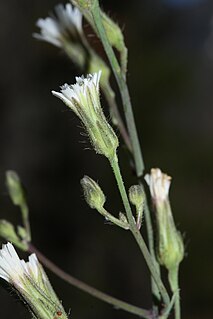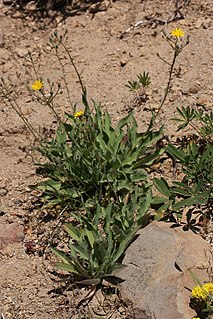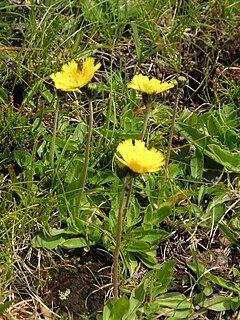
Hieracium , known by the common name hawkweed and classically as hierakion, is a genus of the sunflower (Helianthus) family Asteraceae), and closely related to dandelion (Taraxacum), chicory (Cichorium), prickly lettuce (Lactuca) and sow thistle (Sonchus), which are part of the tribe Cichorieae. Hawkweeds, with their 10,000+ recorded species and subspecies, do their part to make Asteraceae the second largest family of flowers. Some botanists group all these species or subspecies into approximately 800 accepted species, while others prefer to accept several thousand species. Since most hawkweeds reproduce exclusively asexually by means of seeds that are genetically identical to their mother plant, clones or populations that consist of genetically identical plants are formed and some botanists prefer to accept these clones as good species whereas others try to group them into a few hundred more broadly defined species. What is here treated as the single genus Hieracium is now treated by most European experts as two different genera, Hieracium and Pilosella, with species such as Hieracium pilosella, Hieracium floribundum and Hieracium aurantiacum referred to the latter genus. Many members of the genus Pilosella reproduce both by stolons and by seeds, whereas true Hieracium species reproduce only by seeds. In Pilosella, many individual plants are capable of forming both normal sexual and asexual (apomictic) seeds, whereas individual plants of Hieracium only produce one kind of seeds. Another difference is that all species of Pilosella have leaves with smooth (entire) margins whereas most species of Hieracium have distinctly dentate to deeply cut or divided leaves.
A dry roadside dotted with small, ¾ inch red orange flowers, interspersed with very similar yellow ones, and often the white of daisies, is a good sign that you are in Hawkweed country.

Pilosella officinarum, known as mouse-ear hawkweed, is a yellow-flowered species of flowering plant in the daisy family Asteraceae, native to Europe and northern Asia. It produces single, lemon-coloured inflorescences. Like most hawkweed species, it is highly variable and is a member of a species complex of several dozens of subspecies and hundreds of varieties and forms. It is an allelopathic plant.

Pilosella albiflora is a common and widespread North American plant in the sunflower family, known by the names white hawkweed and white-flowered hawkweed.

Hieracium umbellatum, the Canadian hawkweed, Canada hawkweed, narrowleaf hawkweed, or northern hawkweed, is a flowering plant in the daisy family Asteraceae.

Pilosella caespitosa is like several other Pilosella species and has a similar appearance to many of the hawkweeds.

Pilosella scouleri is a North American species of flowering plant in the dandelion tribe within the sunflower family. It is known as Scouler's woollyweed. It is native to western North America, from British Columbia and Alberta in Canada, south to northern California and Utah in the United States.
Pilosella floribunda is a species of noxious and herbaceous perennial plant from family Asteraceae that is known in Europe and can also be found in United States and Canada. It was believed that it was a hybrid of Pilosella caespitosa (Hieracium caespitosum and Pilosella lactucella.

Pilosella lactucella is a species of perennial plant from the family Asteraceae, found in Europe, New York and Nova Scotia (Canada). It is 9–20 centimetres (3.5–7.9 in) in height, with stems from 1–2 millimetres (0.039–0.079 in) wide. The leaves are spatula shaped and 5–8 centimetres (2.0–3.1 in) wide. The flowers bloom from May to July, the heads of which are 2–5 centimetres (0.79–1.97 in) tall. It was once described by Carl Linnaeus as Hieracium auricula and Pilosella auricula, but was recategorized by A. E. Roland and M. Zinck in 1998.
Pilosella friesii – not to be confused with the European P. schultesii – is a North American plant species in the dandelion tribe within the sunflower family. It is widespread across much of Mexico with a few populations in Guatemala and western Texas.
Hieracium submarginellum is a species of flowering plant belonging to the family Asteraceae.
Hieracium ravidum is a species of flowering plant belonging to the family Asteraceae.
Hieracium oistophyllum is a species of flowering plant belonging to the family Asteraceae.
Hieracium hjeltii is a species of flowering plant belonging to the family Asteraceae.
Hieracium fulvescens is a species of flowering plant belonging to the family Asteraceae.
Hieracium coronarium is a species of flowering plant belonging to the family Asteraceae.
Hieracium distendens is a species of flowering plant belonging to the family Asteraceae.
Hieracium caespiticola is a species of flowering plant belonging to the family Asteraceae.
Hieracium caesium is a species of flowering plant belonging to the family Asteraceae.
Hieracium duriceps is a species of flowering plant belonging to the family Asteraceae.
Hieracium sylvularum is a species of flowering plant belonging to the family Asteraceae.





